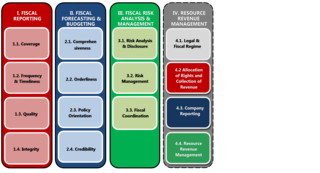Posted by Alpa Shah[1]
Following an initial public consultation in 2015, the IMF has released a revised draft of its Natural Resource Fiscal Transparency Code for further discussion and comment, now available on the consultation webpage.
In 2014, the IMF released Pillars I to III of the new and revised Fiscal Transparency Code (FTC). To address the important and specific transparency considerations for resource-rich countries, an initial draft of the Resource Revenue Management pillar (Pillar IV) was released for public consultation in December 2014, attracting extensive comments and feedback from a range of extractive industry stakeholders. In addition, two Fiscal Transparency Evaluations conducted in Peru and Tanzania in 2015 included pilot chapters assessing the principles of Pillar IV. Reflecting both feedback from the consultation and experience of the two pilots, the IMF is now releasing a revised draft of the entire Fiscal Transparency Code for further discussion and comment.
The revised draft Code now includes augmented versions of Pillars I, II and III, covering issues related to reporting, budgeting, and risk management of natural resources (see figure below). By emphasizing natural resource issues in Pillars I-III, the new draft responds to calls for dedicated principles on important natural resource transparency considerations such as those associated with national resource companies, resource revenue forecasting, commodity price risk analysis, allocation of resource revenues to sub-national governments, and public participation in the resource revenue management process.
In turn, Pillar IV has also been modified to emphasize specific transparency issues associated with the legal and fiscal regime governing the extraction of natural resources, the allocation of resource rights holdings, reporting by companies engaged in resource extraction activity, and the governance and operation of natural resource funds.
Natural Resource Fiscal Transparency Code Pillars (click image to enhance)
The draft Code seeks to provide a comprehensive framework for measuring and evaluating transparency, covering the entire resource revenue management chain, from the creation and allocation of resource rights, to revenue forecasting, collection, budgeting and utilization. It also aims to reflect the importance of changes in commodity markets and the structure of the extractive industries in recent years, and takes into account the development of new natural resource transparency standards and initiatives, such as the Extractive Industries Transparency Initiative, national mandatory reporting standards, and emerging norms such as the publication of resource contracts and the disclosure of beneficial owners of resource rights.
The natural resource FTC will underpin IMF Fiscal Transparency Evaluations for resource-rich countries, identify strengths and weaknesses in fiscal disclosure, and make targeted recommendations for improvements in resource revenue transparency. In addition to the Peru and Tanzania pilots conducted to date, the IMF will carry out further pilot evaluations of all four pillars of the FTC prior to finalizing the Code. The Code will also inform the Guide on Resource Revenue Transparency and Accountability which will be released for consultation in Spring 2017.
We invite comments from all stakeholders of the extractive sector – government officials, parliamentarians, private sector entities, practitioners in the field of resource revenue management, and civil society organizations. The online consultation process will be open until September 9, 2016. We would welcome input by e-mail to IMFConsultation@imf.org.
[1] Economist, Tax Policy Division, Fiscal Affairs Department, IMF.
Note: The posts on the IMF PFM Blog should not be reported as representing the views of the IMF. The views expressed are those of the authors and do not necessarily represent those of the IMF or IMF policy.







